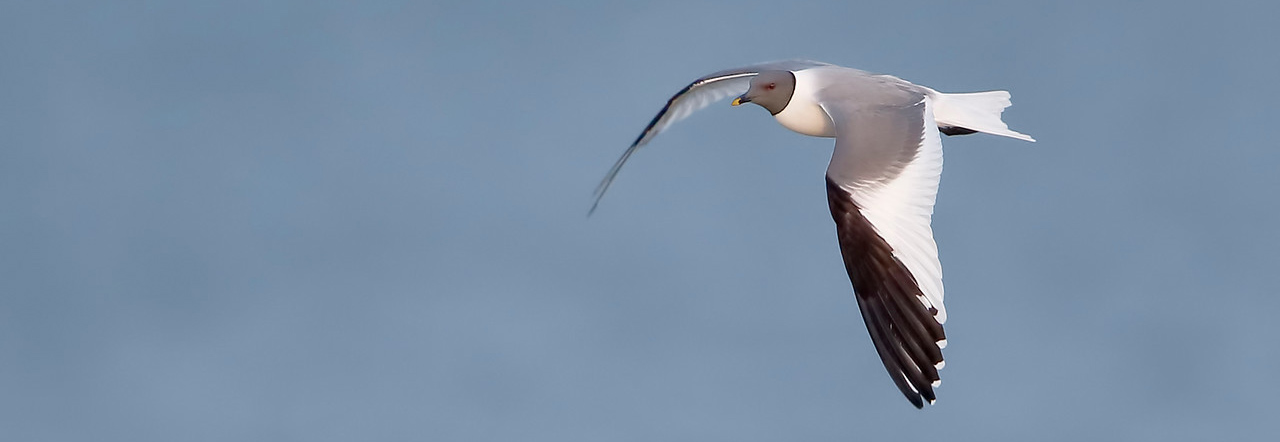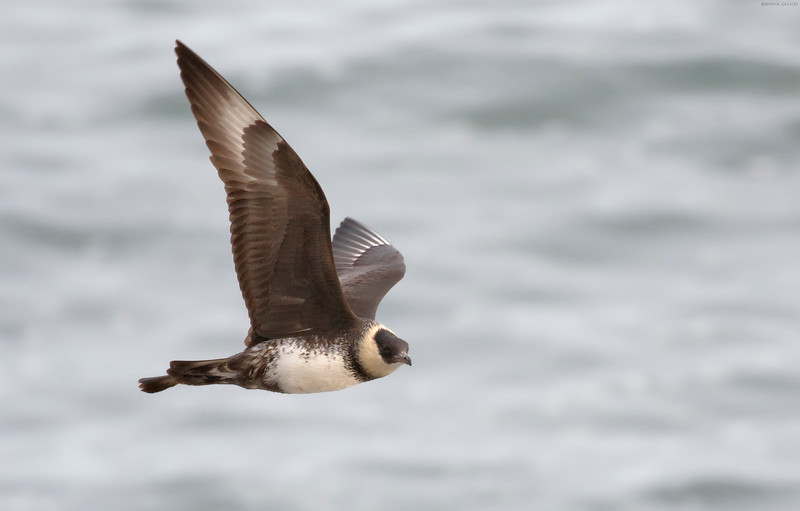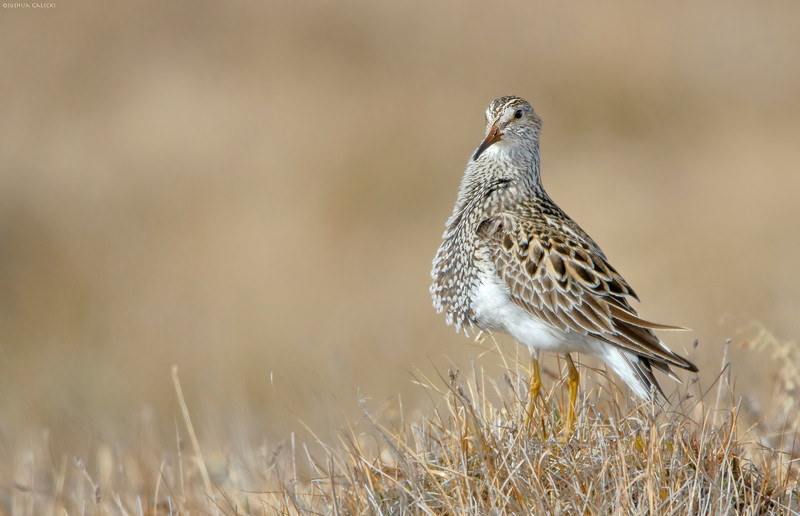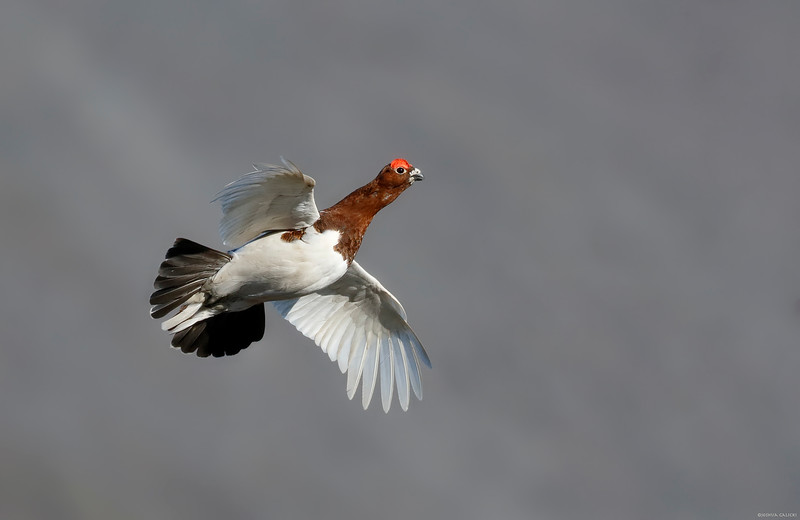Alaska: Birding the Outposts
| Intro | Itinerary | Tour Pricing & Information | Gallery | Bird List | Registration |
2-16 June 2018 Main Tour, 17-21 Pribiloffs Extension
Day 1 Arrival in Anchorage – 2nd June
Our tour begins with your arrival in Anchorage. Depending upon your arrival time, we’ll get you checked into your hotel, enjoy a quick something to eat and then leave for a short visit to some nearby birding areas where we could see some commoner birds such as American Wigeon, Green-winged Teal, Red-necked Phalaropes, Bonaparte’s and Mew Gulls, Rufous Hummingbird, Violet-green Swallow, Varied Thrush, Myrtle Warbler, Pine Siskin or Red Fox Sparrow. Night Anchorage.
Days 2 – 5 Nome
After our morning flight to Nome which is located beside the Being Sea and is a mecca for birders wanting to experience the best of arctic birding, we’ll spend the remainder of our day east of Nome near Safety Lagoon. One should expect to encounter a good variety of birds even though we travel only a short distance from town. Our first divers, eiders, Tundra Swan, Black Brant, White-winged Scoter, Long-tailed Duck, displaying shorebirds including Hudsonian Whimbrel, Pacific and American Golden Plovers, Semipalmated Sandpiper, Wandering Tattler, Surfbirds, Black Turnstones, Long-tailed Skuas, Eastern Yellow Wagtails will all present themselves. As it does not get dark here until very late as we’re just below the Arctic Circle, we’ll need to keep an eye on the clock so that we don’t stay out too late!
We’ll cover all of the roads leading from Nome:
- North along the Kougarok Road looking for tundra species and two of the rarest breeding birds in North America—Bluethroat and Bristle-thighed Curlew. We’ve never missed this dynamic duo and we’ll have time to search until we’re successful. We’ll enjoy other species of note as we travel through this singularly beautiful and desolate area including Gyrfalcon, Willow and Rock Ptarmigan, Eastern Yellow Wagtail, American Pipit, Northern Wheatear and a host of newly arrived migrants.
- East along the Council Road visiting Cape Nome, Safety Lagoon and the mouth of the Nome River. We’ll search for Pacific and Arctic Loons, shorebirds, three jaegers, Arctic and Aleutian Terns and hope for an Asian stray & there’s sometimes Emperor Goose present here as well. As we near Council we begin to encounter more trees and their resident species. Arctic Warbler, Varied Thrush, Arctic Redpoll, warblers like Wilson’s, Blackpoll, Orange-crowned and Northern Waterthrush and, if extreme luck is with us, perhaps a Boreal or Northern Hawk Owl.
- North along the Teller Road covering vast expanses of rocky tundra. Here Rock Ptarmigan, Rough-legged Hawk, Black-bellied Plover, White Wagtail and Northern Wheatear are more easily found. Willow thickets along rushing rivers hold singing Wilson’s & Orange-crowned Warblers, Northern Waterthrushes, Grey-cheeked Thrush, Bluethroat, American Tree Sparrow and Arctic Warbler, along with shedding Musk Oxen! This area has had its share of goodies in recent years as well, with Common Ringed-Plover, Common Sandpiper, Red-throated Pipit and Hawfinch providing the most exciting examples.
And we have plenty of time to locate the enigmatic, rare and hard-to-find Bristle-thighed Curlew. Whilst non-birding highlights could include American Beaver, Caribou and Musk Ox. Nights in Nome.
Day 6 Nome – Anchorage – Barrow
We’ll have time to enjoy one last bit of birding near Nome before checking out of the hotel and transferring to the airport for our flight to Barrow. Maybe a close Rough-legged Buzzard, Slaty-backed Gull or some stately Sandhill Cranes will entertain us before our departure. Upon arrival we’ll check into our hotel, enjoy a quick dinner then depart for some birding in the lovely evening light.
Upon our arrival, both the Beaufort and Chukchi Seas are likely to be icebound. In order to be prepared for cold temperatures (20 to 40 degrees F without wind-chill) during our stay, you need to have heavy winter clothing that can be layered to combat the elements. Likewise, tall waterproof footwear is required to navigate the wet, thawing tundra. As the sun never sets upon Barrow during the summer months, we’ll have optional after-dinner outings (the light for photography can be beyond spectacular) for anyone interested…with the stamina! During our visit to Barrow, we’ll focus on finding Spectacled and Steller’s Eiders, high arctic breeders and any vagrants that we might be able to find. Night in Barrow
Days 7 – 8 Barrow
After our first breakfast above the Arctic Circle, we’ll begin exploration of various roads around Barrow and we plan to travel all of the area’s accessible roadways. Not as difficult as you might think as there are only about 55 miles of tracks we’ll be able to travel. While we’ll stay on roadways most of the time, tundra is wet and, as stated above, you’ll want high waterproof footwear so that closer views/photos of nesting eiders, loons, shorebirds and other goodies like Snowy Owl is possible. The surrounding tundra teams with frantic shorebirds preoccupied with their breeding displays. Examples include Pectoral, Baird’s, Buff-breasted and, with a bit of good fortune, White-rumped or Sharp-tailed Sandpipers. During good years for lemmings, Snowy Owls and Pomarine Jaegers may be quite common.
On one day an evening outing to Point Barrow is planned (if the necessary vehicles are available) as that’s the best time to search for mammals. We’ll look hard for Polar Bears. In Spring they are often found near whale carcasses that have been hauled onto the beach by local natives. If conditions are favorable (i.e. carcasses are present and the pack ice is nearshore), our chances of finding one of these glorious animals is quite good. We’ll also search for avian specialties of the point as well. Examples include the striking trio of Spectacled, Steller’s and King Eiders, Yellow-billed Loon, Black Guillemot and Common Black-headed Gull. Other gulls such as Ivory and Ross’s are rare at this time of the year, but we have found them in the past. Open water can be present at the very tip of the point with birds often seeking shelter there. We’ll see what our visit brings to us. If all else fails, you can still say you stood at the northernmost point of the United States. We’ll take the requisite group photo to prove it! Nights in Barrow.
Day 9 Barrow – Anchorage
Today is a clean-up day! We’ll spend our hours searching for any regular species that might have eluded us thus far. We’ll use the rest of our time to search for rarities like Ruff, Red-necked Stint, Curlew Sandpiper and maybe one of the rare gulls. We’ll drive Barrow’s now familiar roads, checking the customary lakes, melt ponds and open water along the shore before taking a flight back to Anchorage. Night in Anchorage.
Day 10 Anchorage – Seward
We can begin the day at nearby Westchester Lagoon where shorebirds could include Hudsonian Godwit and Short-billed Dowitcher amongst others. We’ll enjoy stops at several locations for woodland or water species on the drive down the scenic Kenai Peninsula. Although the drive is only 130 miles, we’ll spend most of our day en route, taking our time to search for woodland birds amid colorful backgrounds. An incredible mountain backdrop with large pine forests and some of the most scenic country in the world are the order of the day. Birds are not be forgotten however! We should be able to find American Dippers in some of the streams near Turnagain Arm, as well as Rufous Hummingbird, Red-breasted Nuthatch, Olive-sided Flycatcher, Wilson’s Warbler, Black-billed Magpie, Steller’s Jay, Northwestern Crow, Chestnut-backed Chickadee, Dark-eyed Junco, Varied Thrush, Red Crossbill and Golden-crowned Sparrow in the the huge forests of the Kenai Peninsula and, of course, seabirds once we arrive in Seward. There is also a chance of seeing Dall’s Sheep today as well. Night in Seward.
Day 11 Kenai Fjords National Park
Most of our day will be spent aboard our vessel exploring Resurrection Bay, Aialik Cape, Holgate Arm and other areas of the Kenai Fjords National Park, the Chiswell Islands and the Alaska Maritime National Wildlife Refuge. We will be on the longer, more leisurely 9 hour Northwestern Fjord Tour. This gives us as ample time to look at the many seabirds such as Pelagic and possibly Red-faced Cormorant, Horned and Tufted Puffins, Marbled Murrelets, Pigeon Guillemots and Cassin’s, Parakeet, Crested and Rhinoceros Auklets. This is also the most reliable tour itinerary to get us great looks at both Kittlitz’s and Ancient Murrelets along with many marine mammals including Steller’s Sea Lion, Sea Otter, Dall’s Porpoise, Humpback Whale and Orca, calving glaciers and awesome scenery. This is an enjoyable, leisurely, near-shore nature cruise, not like a deep sea pelagic trip. We spend much of our time in close-shore habitats viewing seabird cliffs, glaciers, shoreline scenery and islands. We’ll have a continental breakfast and lunch aboard the boat and return to Seward in time for an evening walk before a fresh seafood dinner overlooking the harbour. Night in Seward.
Day 12 Seward – Denali National Park
Today you’ll bird amid large Sitka Spruce forests near Seward and these incredibly large trees have an aura all their own. Most of the birds we encounter will be familiar from our trip down the Kenai Peninsula just a few days prior but we’ll have a chance to walk trails under immense trees listening to the sounds of Varied Thrushes, Chestnut-backed Chickadees and Townsend’s Warblers singing from the shadows which is reason enough to spend our morning doing just that. We may revisit many of the same areas of two days ago on our drive from Anchorage, enjoy a hike to the face of the Exit Glacier, try one more search for any of the birds we may have missed, find another chance for photographs of some of the more scenic areas and spend time enjoying the quiet beauty of the Kenai Peninsula. Let’s hope for an American Black-backed Woodpecker somewhere today, along with Golden-crowned Kinglet, Bohemian Waxwing, Grey Jay, Sooty Fox Sparrow and some decent chances to find a Black Bear. We aim to arrive at our lodging in time to do a bit of exploring along some of the more remote side roads for Northern Hawk Owl, Spruce Grouse and other woodlands species. Night near Denali.
Day 13 Denali National Park
After breakfast, we’ll catch our bus that takes us across Denali’s amazing landscape. While we’ll still look for birds, it’s usually mammals that steal the show. Moose, Caribou, Wolf and Grizzly Bear are likely subjects and even Lynx and Wolverine have been seen on previous tours. From stark cliffs to rolling tundra we’ll cover Denali’s acres with our entire day devoted to exploring and experiencing all the park has to offer. Hope for clear weather around Mount McKinley (6195m) that will allow photography of North America’s tallest peak, a rarity in the month of June. Night near Denali.
Day 14 Denali Highway
Our morning will be spent travelling along the Denali Highway. The simple east-west route of the Denali Highway belies the birding and wildlife potential of this spectacular region minus the continual traffic of tour buses and rank commercialization that has come to dominate the open-to-the-public portions of Denali National Park itself. We’ll explore boreal forest, taiga, subalpine and alpine habitats for Alaskan breeding birds such as Trumpeter Swan, Barrow’s Goldeneye, Surf and White-winged Scoters, Horned and Red-necked Grebes, Spruce and Ruffed Grouse, Rock and Willow Ptarmigans, Upland Sandpiper, Greater and Lesser Yellowlegs, Golden Eagle, Northern Hawk-Owl, American Three-toed Woodpecker, Northern Shrike, Boreal Chickadee, Bohemian Waxwing, Grey-cheeked, Hermit & Swainson’s Thrushes, Rusty Blackbird, Arctic Warbler, White-winged Crossbills, Pine Grosbeaks, and more. Mammals aren’t to be forgotten and Moose, Caribou, Dall Sheep, Grizzly Bear, Red Fox and Beaver are all possible. Night Denali Highway.
Day 15 Denali Highway – Anchorage – End of Tour – 16th June
Our final morning of birding Alaska’s wilderness along the Denali Highway. One last chance for the rare Smith’s Longspur, Bohemian Waxwing, Arctic Warbler and the other birds we’ve come to know. We’ll bird our way slowly back to Anchorage where we expect to arrive about 5:00pm, where our tour ends. We have a day room reserved to allow everyone to shower, change clothes and prepare for their flights home. Folks whose flights are later in the day on June 16th or are continuing on to the Pribiloff’s extension will be overnight in Anchorage.
PRIBILOFFS EXTENSION: 17th – 21st June
Days 16 – 18 Anchorage – St Paul
This morning we will fly to the island of St Paul situated some 800 miles from Anchorage in the Pribiloffs and all the excitement and thrill of the awesome seabird colonies here. In fact, there are an estimated three million seabirds nesting here! Here, we can observe numerous alcids at very close quarters in many cases, such as Tufted and Horned Puffins, Crested, Parakeet and Least Auklets, and Brunnich’s Guillemots (Thick-billed Murre). The extremely localised Red-faced Cormorant should also pose very well for our cameras, along with Rock Sandpiper, Red-legged Kittiwake and Glaucous-winged Gull. There aren’t many breeding passerines but what there is should keep us occupied, such as Grey-crowned Rosy-Finch, Pacific Wren, and both Snow and Lapland Buntings. Numerous lakes and lagoons host breeding shorebirds and wildfowl that should give us some great photo opportunities of species such as Harlequin and Long-tailed Ducks, Rock Sandpiper, Glaucous-winged Gull, and even rarer gulls such as Vega or Slaty-backed, but we also need to keep an eye out for Asiatic vagrants as this is prime time for something truly rare to show up. But we’ll have to be extremely lucky to catch a lingering McKay’s Bunting. Overall photo opportunities should be excellent (weather permitting) and we can also see Arctic Foxes here as well.
Day 19 St Paul – Anchorage
We have a final morning’s birding here before flying back to Anchorage, where we will transfer to a motel for a rest, pack and enjoy a final meal together before our late afternoon/early evening flights. Night in Anchorage.
Day 20 End of Tour – 21st June
Departing international flights and the end of an extraordinary Alaskan adventure.
Leaders: Kim Risen and Nick Bray.
| Intro | Itinerary | Tour Pricing & Information | Gallery | Bird List | Registration |







